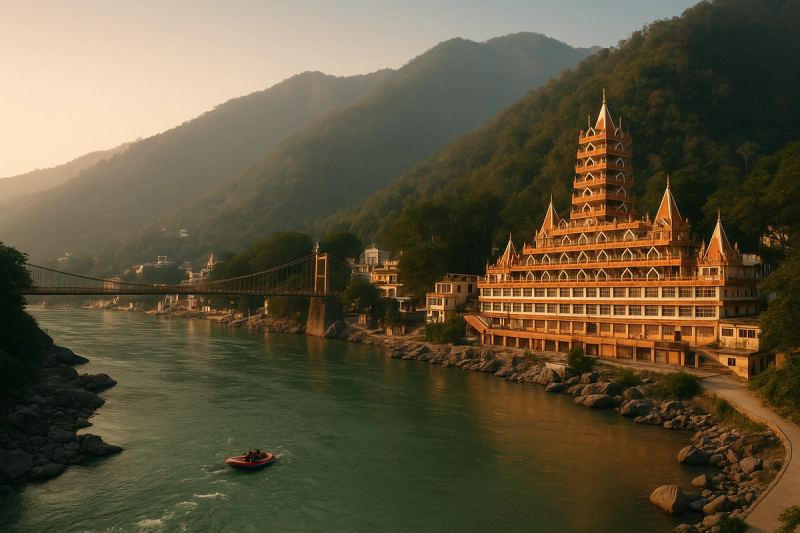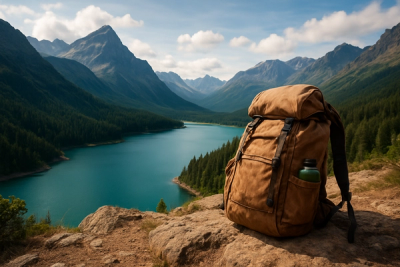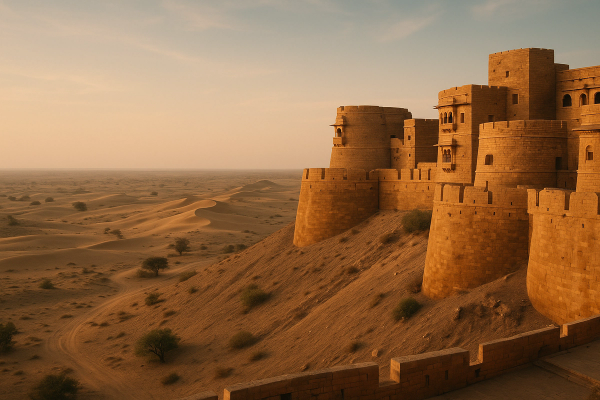Rishikesh Adventure Guide: Rafting, Bungee & Yoga Weekend (Real Talk, Real Thrills)#
Okay so, quick heads up before we dive in: I’m writing this in a first–person, chatty way because that’s how travel tips actually get remembered. Treat it like you’re having chai with a friend who’s obsessed with small details and also, occasionally, forgets stuff. Rishikesh hits differently, yaar. The mountains open up, the Ganga is doing her own dramatic thing, and in one weekend you can go from freezing your face off on a raft to a soft, blissful evening aarti where time… just slows. I’ve stitched this guide from on-ground notes, chats with local operators, and what travellers have been doing lately. Expect a bit of masala: personal takes, tiny mistakes, and those tiny hacks that save you money. And yes, you can totally do rafting + bungee + yoga in 2.5–3 days without burning out. Paisa-vasool, full power.¶
Why Rishikesh, and honestly, when to go#
Rishikesh is that rare mix: real-deal Himalayan adventure plus spiritual calm that’s not all preachy-preachy. It’s vegetarian city limits, alcohol-free, and still somehow super fun. The best months for a mixed weekend are October to March for cool weather and clear skies. Rafting season usually runs October to June, then gets restricted in peak monsoon (roughly July–September) based on Uttarakhand government guidelines and water levels. Winter rafting is cold but epic; operators hand you life jackets and sometimes splash jackets, but carry a thermal or quick-dry tee. March is special because of the International Yoga Festival at Parmarth Niketan, but it’s crowded, so book stays early. Shoulder months like late September or early April feel lighter on the wallet and still great for river levels. Try to avoid heavy monsoon weeks unless you’re just coming for yoga, cafes, and waterfalls in full flow (but also landslides can happen; safety first, yaar).¶
Getting there & getting around (no-nonsense) #
From Delhi, road time is 5–7 hours depending on traffic and how brave you are with chai breaks. Buses run day and overnight from ISBT Kashmere Gate to Rishikesh and Haridwar; Volvo/AC options are decent and cost-effective. Nearest big railhead is Haridwar Junction (about 25 km), which has plenty of trains from Delhi and beyond; Yog Nagri Rishikesh station has limited connectivity but is improving bit by bit. The closest airport is Dehradun’s Jolly Grant (DED), roughly 35–45 minutes to Rishikesh depending on where your stay is; prepaid taxis and app cabs are available, expect around 1200–2000 INR. Inside town, e-rickshaws and shared autos are the vibe; scooters rent for 500–800 INR per day (carry license, helmet mandatory, cops are active with e-challans). Parking near Ram Jhula/Lakshman Jhula/Tapovan gets tight on weekends. Lakshman Jhula is mostly closed for vehicles with intermittent maintenance; use Ram Jhula or the newer pedestrian-only Janaki Setu to cross peacefully. UPI works everywhere, network strength is solid with Jio/Airtel. Do download offline maps; on the rafting or waterfall roads, 4G can be moody.¶
Where to stay (areas, vibes, realistic prices)#
Pick your base like you pick your playlist. Tapovan and Lakshman Jhula side are backpacker-central: hostels, yoga studios, cafes with vegan pancakes and masala omelettes, sunset views. Dorm beds are usually 500–1000 INR, private rooms 1200–2500 INR—clean, social, sometimes noisy. Muni-ki-Reti and Swarg Ashram are calmer, walkable to aartis, good for older folks or anyone who wants low drama nights. Shivpuri/Byasi are for river-facing staycation vibes—forest camps and glamping-style river resorts that offer rafting packages; do check they’re licensed and not in restricted riverbed zones (rules are strict for eco reasons). Mid-range hotels in Tapovan hover around 3000–6000 INR; luxury riverside stays can go 10k–25k+ in season. Prebook for long weekends; same-day jugaad works on weekdays, but don’t push it in peak season or during major events. Most places take UPI, but keep some cash for chai waala and entry tickets.¶
Rafting 101: stretches, costs, and staying safe without killing the vibe#
Rafting is the heartbeat of a Rishikesh weekend. Classic stretches: Brahmapuri to Rishikesh (easy, ~9 km, good for first-timers or families), Shivpuri to Rishikesh (most popular, ~16 km, mix of fun rapids like Roller Coaster and Golf Course), Marine Drive to Shivpuri (~12 km) and the longer Kaudiyala runs for experienced paddlers when conditions allow. Prices vary with distance and season, but expect roughly 600–1000 INR for the shortest run, 1200–2000 INR for Shivpuri, and upwards for longer sections. Book only with licensed operators—permits and daily dispatch lists are monitored by Uttarakhand Tourism, and crews should issue proper gear: ISI/CE helmets, good PFDs, throw bags, first aid. Minimum age & weight limits vary; many operators prefer 12+ for most runs and have 40–100 kg windows. Morning slots are calmer, less wind, fewer rafts clogging rapids. Keep your phone in a locker or a dry bag provided; most operators don’t let you carry it onboard anyway. Water levels can fluctuate with Tehri dam releases; if they call off a departure, it’s not drama, it’s discipline. Monsoon closures are normal; don’t argue with the river, she don’t negotiate.¶
Bungee, giant swing, and zip: the adrenaline sandwich#
Mohan Chatti (around 20–25 km from Tapovan) is where the famous fixed-platform bungee lives, run by Jumpin Heights—a name you’ll see plastered on t-shirts all over town. The bungee is 83 meters, which is tall enough to make your soul step out for a tea. Booking ahead is smart, especially weekends and holidays; slots fill fast. Pricing depends on season and combo deals, but the bungee alone typically falls in the 3700–4500 INR range, with photos/videos extra (often 600–1200 INR). The giant swing is equally wild and the Flying Fox zip is a good add-on if your knees are still stable. There are weight and health restrictions—commonly 35–110 kg for bungee, no heart/back issues, etc.—and you’ll sign a waiver. The crew is professional, very matter-of-fact, and will gently roast you if you keep peeking over the edge. Go light on breakfast if you’re nervous; hydrate, but don’t chug. And tbh, it’s worth the money just for that certificate that says you jumped. You did the thing.¶
Yoga & aarti without getting overwhelmed#
Rishikesh has infinite yoga, from drop-in sunrise Vinyasa to restorative evening Yin. Tapovan lanes are dotted with studios; drop-in classes are usually 300–800 INR. If you want a more traditional flavour, try morning satsang and breathwork at ashrams like Parmarth Niketan or Sivananda (check schedules the night before). Beatles Ashram (Chaurasi Kutia) is a dreamy detour—graffiti, forest silence, old meditation cells; timings generally 10 am–4 pm and entry is ticketed (Indians pay much less than foreign nationals; carry cash or UPI). For aarti, Triveni Ghat is raw and powerful—local families, bhajans, floating diyas; Parmarth Niketan’s aarti is more organized and photogenic. Dress modestly, leave footwear properly parked, and keep the phone down for a minute; let the sound do what it does. Even if yoga is not your jam, a simple morning stretch by the ghat or breathing practice with the river breeze feels like a soft reset. No sermons, just space.¶
A 3-day plan that actually works (and doesn’t feel rushed)#
Day 1: Roll in by noon. Check-in, shower off the bus dust, and wander Tapovan lanes. Late lunch at a cafe with a balcony—order something basic because your stomach needs to catch up, not show off. Stroll to Ram Jhula by sunset; do Parmarth Niketan aarti on one side or Triveni Ghat if you’re up for a short auto ride. Early night, hydrate, stretch a bit. Day 2: Rafting morning slot from Shivpuri. Return, hot chai, a gloriously random aloo paratha. Short nap. Afternoon drive to Mohan Chatti for bungee/swing combo. Back by evening; legs might shake, heart will be singing. If energy is left, night walk on the ghats—quiet, peaceful, stars if you’re lucky. Day 3: Sunrise Kunjapuri Temple (drive up + short climb) or a gentler plan: drop-in yoga, late breakfast, and Neer Garh waterfall before heading home. Pick one big thing each day, not three. Give the place some breathing room; you’ll end up liking it more.¶
Food & cafe crawl (veg only, but you won’t miss meat, chill)#
Officially, Rishikesh is vegetarian and alcohol-free. Still, the food scene is wild. Tapovan area is cafe central—smoothie bowls, hummus plates, masala pasta, Nutella crepes, all that Instagram universe. Try Little Buddha Cafe for views, Pumpernickel German Bakery for bakes and coffee, Bistro Nirvana for consistent food and a relaxed atmosphere. Old-school? Chotiwala near Ram Jhula is iconic (there are two, both claim og status, lol); go for dal, kadi, and that classic North Indian thali vibe. Don’t skip pahadi dishes if you spot them—kafuli (spinach), phaanu (lentil mix), chainsoo (urad), and jhangora kheer (barnyard millet dessert) at local veg spots or simple dhabas. For evening munching, Triveni Ghat area has chaat and kulhad doodh waiting for you. Coffee snobs will survive; espresso culture is decent. And chai by the river hits like a memory—you’ll crave it later at some random Tuesday meeting, guaranteed.¶
Hidden corners that low-key made the trip#
Neer Garh Waterfall is close enough for a half-day; go early because it turns into a mela after 10:30 am, entry is ticketed, and shoes grip matters on the rocks. Kunjapuri Temple for sunrise—on a clear day, the Garhwal snow peaks glow like someone secretly turned up the contrast. Vashishta Gufa near Gular is a meditation cave, very silent, slow your steps and let eyes adjust to darkness; it’s not for selfies, it’s for breath. Phool Chatti and Garud Chatti waterfalls are smaller but way calmer if you time it right. If you’re driving towards Byasi/Kaudiyala, stop at a roadside dhaba for aloo-pyaaz paratha with white butter; the Ganga’s colour up there is an unreal shade of emerald in winter sun. And, btw, Janaki Setu walk at dusk is such a simple pleasure—soft light, bells, the river’s sound… bas.¶
Safety, seasons, and money math in one place (as of now)#
Seasonal rhythms matter. October to March is cool and crisp, great for all three—rafting, bungee, yoga. April to June is warmer, still fine for rafting, but drink water like it’s your job. July to September, monsoon brings charm and chaos; rafting may be restricted or shut depending on levels, and highway landslides do happen in the hills. Always check operator updates the evening before. Choose licensed rafting outfits and certified jump platforms. Wear the helmet and PFD properly—zero negotiations. Any ear/heart/back issues? Inform the team honestly; it’s not heroism to hide it. Costs snapshot so you can plan without mental math: hostels 500–1000 INR (dorm) and 1200–2500 INR (private), mid-range stays 3000–6000 INR, luxe 10k and up. Rafting 600–2000 INR depending on stretch. Bungee 3700–4500 INR, videos extra. Drop-in yoga 300–800 INR. Scooter rentals 500–800 INR/day; airport taxi 1200–2000 INR; e-rickshaw hops inside town 20–150 INR depending on your vibe and the bhaiya’s. Data is current around early 2025-ish, but double-check because prices do creep in season. Keep some cash for small shops; otherwise UPI saves the day.¶
Practical tips I wish I knew before I planned it this way#
Book rafting for the morning on day two—winds pick up later, queues do too. Keep a small towel, quick-dry tee, and strap-on sandals for the raft. Don’t carry your phone on the water unless you’re fine gambling with it; buy the operator’s GoPro footage if you really need the memory. For bungee, lighter breakfast works; no tight belts or dangling jewellery. Prebook bungee on long weekends, and give yourself at least an hour buffer for travel to Mohan Chatti. For waterfalls, wear proper grip footwear; those rocks don’t care about your Instagram Reels. Respect local customs: no smoking on ghats, keep shoulders covered at aarti if possible, don’t litter. Camping must be in legal zones; beach camping directly on the riverbed is restricted under environmental rules—ask to see licenses if unsure. If you rent a scooter, carry DL and helmet or you’ll recieve a surprise e-challan. Network is usually fine, but download maps for the hill stretches. And btw, Rishikesh nights get colder than you think—pack a layer, even if your Delhi weather app is lying.¶
Last thing—and I’m saying this with full dil: Rishikesh isn’t just about ticking boxes. Raft, jump, stretch, sure. But also let yourself be a little idle, sit on the steps by the Ganga, sip chai, talk to the guy selling rudraksha who’s lived here longer than your bucket list exists. That’s the real postcard. If you want more travel stories with actual usable tips and India-first feels, I keep browsing AllBlogs.in now and then—lots of solid, no-fuss info there that helps you plan without twenty tabs open. Safe travels, and ya, don’t forget to breathe on the jump. You’ll be fine. Better than fine.¶














